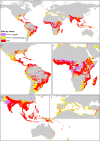Global spatial assessment of Aedes aegypti and Culex quinquefasciatus: a scenario of Zika virus exposure
- PMID: 30474578
- PMCID: PMC6518585
- DOI: 10.1017/S0950268818003102
Global spatial assessment of Aedes aegypti and Culex quinquefasciatus: a scenario of Zika virus exposure
Abstract
Zika virus (ZIKV) is an arbovirus transmitted mainly by Aedes aegypti mosquitoes. Recent scientific evidence on Culex quinquefasciatus has suggested its potential as a vector for ZIKV, which may change the current risk zones. We aimed to quantify the world population potentially exposed to ZIKV in a spatially explicit way, considering the primary vector (A. aegypti) and the potential vector (C. quinquefasciatus). Our model combined species distribution modelling of mosquito species with spatially explicit human population data to estimate ZIKV exposure risk. We estimated the potential global distribution of C. quinquefasciatus and estimated its potential interaction zones with A. aegypti. Then we evaluated the risk zones for ZIKV considering both vectors. Finally, we quantified and compared the people under risk associated with each vector by risk level, country and continent. We found that C. quinquefasciatus had a more temperate distribution until 42° in both hemispheres, while the risk involving A. aegypti is concentrated mainly in tropical latitudes until 35° in both hemispheres. Globally, 4.2 billion people are under risk associated with ZIKV. Around 2.6 billon people are under very high risk associated with C. quinquefasciatus and 1 billion people associated with A. aegypti. Several countries could be exposed to ZIKV, which emphasises the need to clarify the competence of C. quinquefasciatus as a potential vector as soon as possible. The models presented here represent a tool for risk management, public health planning, mosquito control and preventive actions, especially to focus efforts on the most affected areas.
Keywords: Arbovirus; ZIKV risk; exposure level; mosquito; spatial epidemiology.
Figures






References
-
- Velásquez-Serra GC (2016) Zika virus vectors. American Journal of Epidemiology and Infectious Diseases 4, 78–83.
-
- Ayres CFJ (2016) Identification of Zika virus vectors and implications for control. Lancet Infect Diseases 16, 278–279. - PubMed
-
- Mlakar J et al. (2016) Zika virus associated with microcephaly. New England Journal Medicine 374, 951–958. - PubMed
-
- Oliveira Melo AS et al. (2016) Zika virus intrauterine infection causes fetal brain abnormality and microcephaly: tip of the iceberg? Ultrasound in Obstetrics and Gynecology 47, 6–7. - PubMed
LinkOut - more resources
Full Text Sources

